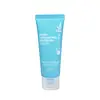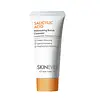What's inside
What's inside
 Key Ingredients
Key Ingredients

 Benefits
Benefits

 Concerns
Concerns

 Ingredients Side-by-side
Ingredients Side-by-side

Water
Skin ConditioningCellulose
AbsorbentGlycerin
HumectantDipropylene Glycol
HumectantBambusa Arundinacea Stem Powder
AbrasiveQuaternium-60
Propylene Glycol
HumectantCarbomer
Emulsion StabilisingCarica Papaya Fruit Extract
Skin ConditioningBambusa Vulgaris Leaf Extract
Skin ConditioningOldenlandia Diffusa Extract
Skin ConditioningLonicera Caprifolium Extract
AstringentYeast Extract
Skin ConditioningLimonia Acidissima Extract
Skin ConditioningAllantoin
Skin ConditioningEthylhexylglycerin
Skin ConditioningHydrolyzed Glycosaminoglycans
HumectantSodium Hyaluronate
HumectantPanthenol
Skin ConditioningHydrolyzed Hyaluronic Acid
HumectantBenzyl Glycol
Solvent1,2-Hexanediol
Skin ConditioningButylene Glycol
HumectantDisodium EDTA
Sodium Acetylated Hyaluronate
HumectantLinalool
PerfumingBenzyl Benzoate
AntimicrobialLimonene
PerfumingParfum
MaskingWater, Cellulose, Glycerin, Dipropylene Glycol, Bambusa Arundinacea Stem Powder, Quaternium-60, Propylene Glycol, Carbomer, Carica Papaya Fruit Extract, Bambusa Vulgaris Leaf Extract, Oldenlandia Diffusa Extract, Lonicera Caprifolium Extract, Yeast Extract, Limonia Acidissima Extract, Allantoin, Ethylhexylglycerin, Hydrolyzed Glycosaminoglycans, Sodium Hyaluronate, Panthenol, Hydrolyzed Hyaluronic Acid, Benzyl Glycol, 1,2-Hexanediol, Butylene Glycol, Disodium EDTA, Sodium Acetylated Hyaluronate, Linalool, Benzyl Benzoate, Limonene, Parfum
Water
Skin ConditioningCocamidopropyl Betaine
CleansingPotassium Cocoyl Hydrolyzed Oat Protein
Skin ConditioningSodium Cocoyl Glycinate
CleansingSodium Lauroyl Sarcosinate
CleansingCorn Starch Modified
AbsorbentHydrated Silica
AbrasiveGlycerin
HumectantSalicylic Acid
MaskingNiacinamide
SmoothingCentella Asiatica Extract
CleansingAloe Barbadensis Leaf Extract
EmollientCamellia Sinensis Leaf Extract
AntimicrobialCalendula Officinalis Flower Extract
MaskingCeramide NP
Skin ConditioningDMDM Hydantoin
PreservativePanthenol
Skin ConditioningAllantoin
Skin ConditioningWater, Cocamidopropyl Betaine, Potassium Cocoyl Hydrolyzed Oat Protein, Sodium Cocoyl Glycinate, Sodium Lauroyl Sarcosinate, Corn Starch Modified, Hydrated Silica, Glycerin, Salicylic Acid, Niacinamide, Centella Asiatica Extract, Aloe Barbadensis Leaf Extract, Camellia Sinensis Leaf Extract, Calendula Officinalis Flower Extract, Ceramide NP, DMDM Hydantoin, Panthenol, Allantoin
 Reviews
Reviews

Ingredients Explained
These ingredients are found in both products.
Ingredients higher up in an ingredient list are typically present in a larger amount.
Allantoin is a soothing ingredient known for its protective and moisturizingg properties. Because of this, it is often added to products with strong active ingredients.
Studies show higher concentrations of this ingredient can promote wound healing.
Though it can be derived from the comfrey plant, allantoin is produced synthetically for cosmetic products to ensure purity.
Learn more about AllantoinGlycerin is already naturally found in your skin. It helps moisturize and protect your skin.
A study from 2016 found glycerin to be more effective as a humectant than AHAs and hyaluronic acid.
As a humectant, it helps the skin stay hydrated by pulling moisture to your skin. The low molecular weight of glycerin allows it to pull moisture into the deeper layers of your skin.
Hydrated skin improves your skin barrier; Your skin barrier helps protect against irritants and bacteria.
Glycerin has also been found to have antimicrobial and antiviral properties. Due to these properties, glycerin is often used in wound and burn treatments.
In cosmetics, glycerin is usually derived from plants such as soybean or palm. However, it can also be sourced from animals, such as tallow or animal fat.
This ingredient is organic, colorless, odorless, and non-toxic.
Glycerin is the name for this ingredient in American English. British English uses Glycerol/Glycerine.
Learn more about GlycerinPanthenol is a common ingredient that helps hydrate and soothe the skin. It is found naturally in our skin and hair.
There are two forms of panthenol: D and L.
D-panthenol is also known as dexpanthenol. Most cosmetics use dexpanthenol or a mixture of D and L-panthenol.
Panthenol is famous due to its ability to go deeper into the skin's layers. Using this ingredient has numerous pros (and no cons):
Like hyaluronic acid, panthenol is a humectant. Humectants are able to bind and hold large amounts of water to keep skin hydrated.
This ingredient works well for wound healing. It works by increasing tissue in the wound and helps close open wounds.
Once oxidized, panthenol converts to pantothenic acid. Panthothenic acid is found in all living cells.
This ingredient is also referred to as pro-vitamin B5.
Learn more about PanthenolWater. It's the most common cosmetic ingredient of all. You'll usually see it at the top of ingredient lists, meaning that it makes up the largest part of the product.
So why is it so popular? Water most often acts as a solvent - this means that it helps dissolve other ingredients into the formulation.
You'll also recognize water as that liquid we all need to stay alive. If you see this, drink a glass of water. Stay hydrated!
Learn more about Water